On this #FossilFriday, my first solo article is published at @BiolJLinnSoc! https://doi.org/10.1093/biolinnean/blaa157 The study assessed 1387 bones of the giant pikas #Prolagus apricenicus and P. imperialis (Late #Miocene) from Gargano palaeo-island and gives clues about their #palaeobiology +
#Prolagus apricenicus and P. imperialis (Late #Miocene) from Gargano palaeo-island and gives clues about their #palaeobiology +
 #Prolagus apricenicus and P. imperialis (Late #Miocene) from Gargano palaeo-island and gives clues about their #palaeobiology +
#Prolagus apricenicus and P. imperialis (Late #Miocene) from Gargano palaeo-island and gives clues about their #palaeobiology +
P. #apricenicus weighed around 150-250 g, whereas P. #imperialis was much bigger (500-750 g) #IslandRule. Their #bodymasses fluctuated over time, with sharp increases related to ecologic perturbations (e.g. increase of island area  ) #Biology +
) #Biology +
 ) #Biology +
) #Biology +
Both species show a stable and less cursorial locomotion, with #leaping skills. Similarly, extant rocky #pikas (long-lived ochotonids), restricted to mountain regions, have a motionless strategy in front of predators, and use leaps for dwelling among rocks #Ecology +
The assessment  of the #postcranial material in several localities has also allowed to identify reliably the occurrence of P. imperialis in a previous site that what was known to date #Paleontology +
of the #postcranial material in several localities has also allowed to identify reliably the occurrence of P. imperialis in a previous site that what was known to date #Paleontology +
 of the #postcranial material in several localities has also allowed to identify reliably the occurrence of P. imperialis in a previous site that what was known to date #Paleontology +
of the #postcranial material in several localities has also allowed to identify reliably the occurrence of P. imperialis in a previous site that what was known to date #Paleontology +
Finally, it was carried out a compilation of the #ecoevolutionary adaptations observed in #ochotonids that dwelled in insular environments #Island Rule #SmallMammals +
They are characterized by a large size, several degrees of #hypsodonty, a large enamel complexity, hypselodonty, lack of cursorial abilities, jumping and digging skills, and a slow #lifehistory #LagomorphsAreCool +
#ConservationPalaeobiology proposes that all this data could help in the #management of extant species, which are threatened by #climatechange. The data points that Sardinian Prolagus could be an excellent reference taxa for this task.
If you are interested in the paleobiology of lagomorphs and insular mammals, take a look to the paper  https://doi.org/10.1093/biolinnean/blaa157
https://doi.org/10.1093/biolinnean/blaa157 

 https://doi.org/10.1093/biolinnean/blaa157
https://doi.org/10.1093/biolinnean/blaa157 

Special thanks to @LorenzoRook, @FirenzeGeologia and @Dstunifi for taking care of these amazing remains!

 Read on Twitter
Read on Twitter


